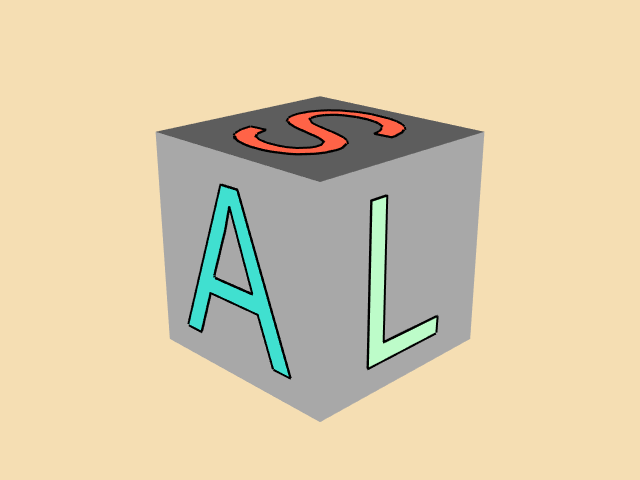AnnotatedCubeActor
Repository source: AnnotatedCubeActor
Description¶
The example demonstrates how to create and label an annotated cube actor.
To colour the individual cube faces, see: ColoredAnnotatedCube.
Other languages
See (Python), (PythonicAPI), (Java)
Question
If you have a question about this example, please use the VTK Discourse Forum
Code¶
AnnotatedCubeActor.cxx
#include <vtkAnnotatedCubeActor.h>
#include <vtkCamera.h>
#include <vtkNamedColors.h>
#include <vtkNew.h>
#include <vtkProperty.h>
#include <vtkRenderWindow.h>
#include <vtkRenderWindowInteractor.h>
#include <vtkRenderer.h>
int main(int, char*[])
{
vtkNew<vtkNamedColors> colors;
// Set up the renderer, window, and interactor.
//
vtkNew<vtkRenderer> renderer;
renderer->SetBackground(colors->GetColor3d("Wheat").GetData());
vtkNew<vtkRenderWindow> renderWindow;
renderWindow->AddRenderer(renderer);
renderWindow->SetSize(640, 480);
renderWindow->SetWindowName("AnnotatedCubeActor");
vtkNew<vtkRenderWindowInteractor> interactor;
interactor->SetRenderWindow(renderWindow);
vtkNew<vtkAnnotatedCubeActor> cube;
cube->SetFaceTextScale(2.0 / 3.0);
// Anatomic labelling.
//
cube->SetXPlusFaceText("A");
cube->SetXMinusFaceText("P");
cube->SetYPlusFaceText("L");
cube->SetYMinusFaceText("R");
cube->SetZPlusFaceText("S");
cube->SetZMinusFaceText("I");
// Change the vector text colors.
//
cube->GetTextEdgesProperty()->SetColor(colors->GetColor3d("Black").GetData());
cube->GetTextEdgesProperty()->SetLineWidth(4);
// clang-format off
cube->GetXPlusFaceProperty()->SetColor(
colors->GetColor3d("Turquoise").GetData());
cube->GetXMinusFaceProperty()->SetColor(
colors->GetColor3d("Turquoise").GetData());
cube->GetYPlusFaceProperty()->SetColor(
colors->GetColor3d("Mint").GetData());
cube->GetYMinusFaceProperty()->SetColor(
colors->GetColor3d("Mint").GetData());
cube->GetZPlusFaceProperty()->SetColor(
colors->GetColor3d("Tomato").GetData());
cube->GetZMinusFaceProperty()->SetColor(
colors->GetColor3d("Tomato").GetData());
// clang-format on
renderer->AddActor(cube);
// Set up an interesting view.
//
vtkCamera* camera = renderer->GetActiveCamera();
camera->SetViewUp(0, 0, 1);
camera->SetFocalPoint(0, 0, 0);
camera->SetPosition(4.5, 4.5, 2.5);
renderer->ResetCamera();
camera->Dolly(1.0);
renderer->ResetCameraClippingRange();
renderWindow->Render();
interactor->Start();
return EXIT_SUCCESS;
}
CMakeLists.txt¶
cmake_minimum_required(VERSION 3.12 FATAL_ERROR)
project(AnnotatedCubeActor)
find_package(VTK COMPONENTS
CommonColor
CommonCore
InteractionStyle
RenderingAnnotation
RenderingContextOpenGL2
RenderingCore
RenderingFreeType
RenderingGL2PSOpenGL2
RenderingOpenGL2
)
if (NOT VTK_FOUND)
message(FATAL_ERROR "AnnotatedCubeActor: Unable to find the VTK build folder.")
endif()
# Prevent a "command line is too long" failure in Windows.
set(CMAKE_NINJA_FORCE_RESPONSE_FILE "ON" CACHE BOOL "Force Ninja to use response files.")
add_executable(AnnotatedCubeActor MACOSX_BUNDLE AnnotatedCubeActor.cxx )
target_link_libraries(AnnotatedCubeActor PRIVATE ${VTK_LIBRARIES}
)
# vtk_module_autoinit is needed
vtk_module_autoinit(
TARGETS AnnotatedCubeActor
MODULES ${VTK_LIBRARIES}
)
Download and Build AnnotatedCubeActor¶
Click here to download AnnotatedCubeActor and its CMakeLists.txt file. Once the tarball AnnotatedCubeActor.tar has been downloaded and extracted,
cd AnnotatedCubeActor/build
If VTK is installed:
cmake ..
If VTK is not installed but compiled on your system, you will need to specify the path to your VTK build:
cmake -DVTK_DIR:PATH=/home/me/vtk_build ..
Build the project:
make
and run it:
./AnnotatedCubeActor
WINDOWS USERS
Be sure to add the VTK bin directory to your path. This will resolve the VTK dll's at run time.
